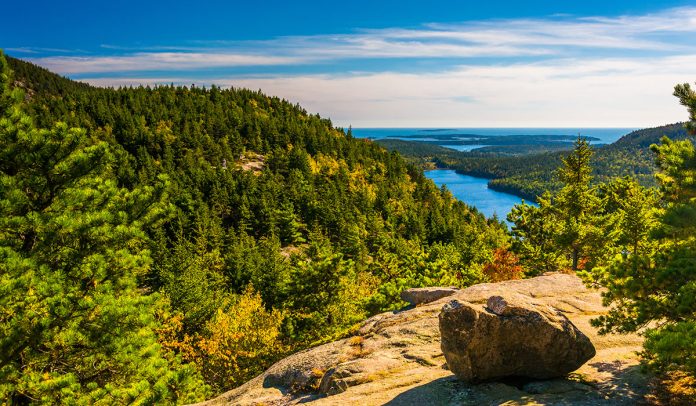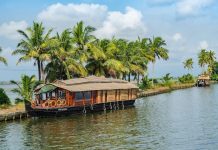Superlative natural wonders appear wherever you turn in the USA’s national parks. Whether you’re working on your bucket list – ‘Climb North America’s highest mountain!’ – or just wanting to hug the world’s largest living tree, you can explore nature’s extreme outer limits at these record-setting US national parks.
 Yosemite Falls is the highest waterfall in the mainland United States
Yosemite Falls is the highest waterfall in the mainland United States
Water, water everywhere
Looking for North America’s highest waterfall? Head to California’s Yosemite National Park, where the triple-decker cascade of Yosemite Falls tumbles 2425 ft into a glacially carved valley. One of the world’s 10 highest waterfalls, Yosemite Falls swells in late spring, when melting snow from mountain peaks roars as it drops into the Yosemite Valley, which conservationist John Muir described as nature’s temple.
 Old Faithful Geyser is one of the most visited sights at Yellowstone National Park
Old Faithful Geyser is one of the most visited sights at Yellowstone National Park
Equally impressive wonders are the spouting geysers of Yellowstone National Park, shared between the states of Wyoming, Idaho and Montana. More geysers are found here than anywhere else on the planet, with superheated water from underground volcanic rocks bubbling to the surface in hot springs, fumaroles and roiling mud pots. Old Faithful, the park’s most famous geyser, erupts more regularly than any other geyser on earth, spouting up to 8400 gallons of water over 100 feet high into the air every hour or two, day and night.
Closer to the West Coast lies the USA’s deepest lake at Oregon’s Crater Lake National Park. The astounding clarity of 1943ft-deep Crater Lake, formed by rainfall in an extinct volcanic caldera, will have you instantly reaching for your camera. Peer over the crater rim from roadside viewpoints or hike down to Cleetwood Cove, where you can catch a boat tour over to Wizard Island, the volcanic cinder cone popping up above the lake’s surface that looks like an enchanted lost world.
 A Denali ‘traffic jam’ lines up near the tallest peak in North America
A Denali ‘traffic jam’ lines up near the tallest peak in North America
From snowy peaks to hot badlands
With global climate change accelerating, you’d better hurry if you want to see North America’s largest collection of glaciers. Of the 25 large glaciers remaining in Montana’s Glacier National Park, several are expected to melt away by 2030. You’re best off heading north to chilly Alaska, where Glacier Bay National Park and Wrangell-St Elias National Park are preserved as a UNESCO World Heritage Site. The number of glaciers there dating from the Little Ice Age – including a few record-breakers that flow for 75 miles or have grown to be 3000 feet thick – is uncountable.
Alaska also boasts the USA’s tallest peak. At 20,030 feet high, Denali (Formerly Mt McKinley)– an Athabaskan word meaning ‘The High One’ – dominates the epic landscapes of Denali National Park. If you can’t journey that far, California’s Sequoia National Park offers the chance to climb Mt Whitney (14,505ft), the highest peak in the Lower 48 states. Towering over the Sierra Nevada range, Mt Whitney’s summit – with its views of craggy granite peaks, not to mention head-spinning elevations – may take your breath away, literally. Sequoia National Park is also home the world’s largest living tree, a giant sequoia that measures over 100 ft around.
 The redwood trees in Sequoia National Park are the largest living things in the world
The redwood trees in Sequoia National Park are the largest living things in the world
Less than 140 miles from Mt Whitney you’ll find the lowest elevation in North America: Badwater. Covering almost 200 square miles of Death Valley National Park, Badwater is one of the world’s largest salt flats. Once a prehistoric lake, this arid spot now sits at an elevation of 282 feet below sea level. Death Valley also holds the unenviable record of being the hottest place in the USA, with the temperature at Furnace Creek hitting an excruciating 134 degrees Fahrenheit on July 10, 1913.
Here’s some more hot stuff for you: Hawai’i Volcanoes National Park on the Big Island of Hawai’i protects what was the world’s longest running continuous volcanic eruption since 1983 – it flowed for over 10,000 days until May 2018. The wonders of the lava lake and glowing flows might have stopped for now, but there’s still plenty of otherworldly sights in this unique environment. You can see what the volcano is doing at the National Park Service’s web site.
 Mammoth Cave in Kentucky has more than 400 miles of passages – the longest in the world
Mammoth Cave in Kentucky has more than 400 miles of passages – the longest in the world
Where more wild wonders are
Hawaii Volcanoes National Park is famous for its walk-through lava tubes, too. But diehard spelunkers should head back to the mainland instead to Kentucky’s Mammoth Cave National Park. There you can crawl inside the world’s longest known cave system, a subterranean maze of chambers that measures almost 400 miles long. Like Carlsbad Caverns National Park in New Mexico, Mammoth Cave is a valuable hot spot for biodiversity and has been declared a World Heritage Site.
If the wonders of biodiversity really have you hooked, you’ll want to fly south to Florida’s Everglades National Park, another World Heritage Site and the largest subtropical wilderness in North America. Watch pink flamingos flock to its crystal bays and sharp-toothed crocodiles and alligators swim beside rivers of grass.
 The Grand Canyon is the longest in the US (though at more than a mile, still not the deepest)
The Grand Canyon is the longest in the US (though at more than a mile, still not the deepest)
Otherwise, if going deep into the bowels of the earth is what fascinates you most, hit the road to Grand Canyon National Park. Though not North America’s deepest canyon, it’s the longest, winding for more than 275 miles along the Colorado River. Peering down into the canyon’s pastel-painted depths at sunset from more than a mile high atop the rim is a view that’s hard to beat.
7 Amazing Natural Wonders in the U.S.
Sequoia National Park
California

To Do: Containing both the highest point in the Lower 48 (Mt. Whitney, at 14,500 towering feet tall) as well as the trees that give the park its name, Sequoia National Park is all about its famous giants. See the General Sherman tree and other wonders of the Giant Forest. Explore acres of dense, ancient forests where trees are routinely hundreds of years old. Spy the foxes, black bears and bobcats that call this national park home. Or discover the Sierra Nevada foothills town of Three Rivers, where the art galleries are abundant with nature photography and local crafts and restaurants serve up hearty, hiker-approved meals.
Must-See Wonder: General Sherman and the Giant Forest, which boasts five of the ten largest trees on Earth.
To Stay: A log house perched in the trees high above Three Rivers, the aptly named Log House Lodge is filled with rustic decor and fascinating antiques, including an old-fashioned gramophone and spinning wheel. It’s just a ten-minute walk to Sequoia National Park, meaning the cozy rooms are exceptionally close after a long day, and the cast-iron wood-burning stove warms up chilly nights.
Rates from $225 per night.
Rates from $225 per night.
Niagara Falls State Park
New York

To Do: Water from four of the five Great Lakes comes together in a thundering, crashing miracle that spans the United States and Canada. View the falls — actually three separate waterfalls — from the Observation Tower, where you might also see a soaring bald eagle or peregrine falcon. Or climb aboard the iconic Maid of the Mist and feel the falls’ spray firsthand, as guests have been doing since 1846. While the area is admittedly a tad touristy, the powerful lure of the falls can’t be overstated — and many locals recommend hopping over to the Canadian side for better views, if you remember to pack your passport.
Must-See Wonder: The Cave of the Winds’ wooden walkway to experience tropical-storm-like conditions of Bridal Veil Falls.
To Stay: You can’t beat this B&B’s location. The Red Coach Inn is just 500 yards from the falls, overlooking the swirling Upper Rapids. In fact, the owners swear it’s close enough to hear the waterfalls’ roar. Most guest rooms and suites also have Niagara views, plus you can make your own waterside fun in the en-suite jetted Jacuzzi tubs found in every room type. The on-site restaurant and wine bar are top-rated, with even more panoramic views of the majestic falls, just in case you can’t get enough.
Rates from $159 per night.
Mammoth Cave National Park
Kentucky

To Do: In the hilly, river-threaded country of south-central Kentucky, you’ll find Mammoth Cave. At 400-some mapped miles, it’s the world’s longest cave system, a grand and sometimes eerie space of dark caverns and serpentine tunnels. The best way to explore the surreal cave is on a ranger-led tour, though advance reservations are strongly recommended, as tours fills fast. Most tours are moderately strenuous, but avid cavers can embark on a true spelunking exhibition, scrambling up rocky slopes and squeezing through tight holes if they so desire. Before or after your subterranean exploration, hike the Green River Bluffs or canoe the 25-mile river itself, bordered by sheer cliffs on either side.
Must-See Wonder: Gothic Avenue, a stretch of cave with a ceiling covered in visitors’ signatures from the 19th century.
To Stay: Just a mile from the entrance to Mammoth Cave National Park is the country-cute Serenity Hill Bed and Breakfast. Rooms are bright with crisp white bed linens and antique furnishings, including gorgeous four-poster beds. Expect freshly made cookies in your guest room each day, and enjoy the beautiful valley view from the wide front porch in this secluded, peaceful retreat.
Rates from $85 per night.
Zion National Park
Utah

To Do: One of Utah’s Mighty Five national parks, Zion is famed for its massive sandstone cliffs, striated in shades of ochre and cream and blush, that seem to brush the blue sky above. Follow the footsteps of early Native American tribes and westward-bound pioneers as you explore the supersized canyons, basin and shrub-covered desert. Challenging trails loop throughout the park, including vertigo-inducing Angels Landing and the far easier, family-friendly Narrows, during which you’ll wade and ford the Virgin River. Not into hiking? A horseback ride is a great alternative way to see the wildlife in all its natural wonder. As its name implies, there’s something heavenly about this national park.
Must-See Wonder: The “hanging gardens” of wildflowers to see bright red Indian paintbrush and sago lilies, Utah’s state flower.
To Stay: The Iron Gate Inn and Winery, located in a pretty powder-blue Victorian, is the area’s oldest B&B, surrounded by gardens and stunning views since the late 1800s. Rooms are furnished in elegantly traditional style, with bright floral duvets that bring the romantic garden feel indoors. With eco-minded practices and vegan toiletries, the Iron Gate is appropriately earth-friendly. Breakfasts are well-known for their liberal use of local produce, jams and honey. Here, you can stargaze southern Utah’s skies from the gardenside Jacuzzi and patio fire pit.
Rates from $119 per night.
Acadia National Park
Maine

To Do: Spotted by Champlain as he sailed down the New England coast, Acadia’s pine forests, its crowning Cadillac Mountain and its tiny coastal islands are sights to behold, stretching over tens of thousands of acres along the Atlantic. Follow the carriage trails and granite bridges laid by gentleman naturalist John D. Rockefeller. Hike to the Bass Harbor Head Lighthouse, listed on the National Register of Historic Places and prettily situated on Mt. Desert Island, once home to the Rockefellers themselves as well as a slew of Vanderbilts, Carnegies and Astors. It’s just a 4-hour drive from Boston to this outdoorsy paradise. Pro tip: While summer is high season for hikers, fall is a special time to visit Arcadia, when the mountainsides bloom in autumnal glory, blanketed in red and gold.
Must-See Wonder: Catching sunrise from Cadillac Mountain. In fall, it boasts the earliest sunrise in the United States (and the prettiest one at that).
To Stay: While many tourists flock to spendy Bar Harbor, you may more enjoy the peaceful seclusion of Acadia’s Oceanside Meadows Inn, located in a whitewashed 1860s sea captain’s home. Guests awaken to sunrise over the private sandy beach, gulls squawking in the near distance, and of course a four-course gourmet breakfast.
Rates from $149 per night.
Great Florida Reef
Florida

To Do: If you thought snorkeling and diving were best reserved for Caribbean islands and Australian beaches, you may be missing out on amazing undersea adventures in your own backyard. Off the coasts of the Florida Keys lies the Great Florida Reef. Some 1,400 species of marine life — including fish, mammals, plants and corals — are found here, the diverse array attracting the snorkelers and swimmers who ply its waters. Especially around Key Largo, visitors find the densest, most colorful corals and swarming schools of parrot fish, turtles, eagle rays and occasionally a nurse shark or two. These reefs, lying in warm and shallow waters, are well suited for beginners learning to dive.
Must-See Wonder: The Christ of the Abyss statue may be manmade, but not so for the brain corals and famous barracuda, Smoky, who call the artwork home.
To Stay: There are B&Bs aplenty in the popular Keys, but we love The Mermaid & Alligator. Nine rooms mix island-style luxury and Victorian elegance. Think gabled roofs and spacious verandahs, spa-style bathrooms and four-poster beds. A complimentary breakfast is served beside the plunge pool and tropical gardens outside.
Rates from $178 per night.
Denali National Park
Alaska

To Do: Denali comprises a mind-boggling six million acres of Alaskan backcountry: alpine forest, mossy tundra and, at its highest elevations, ancient glaciers. With snowcapped Denali (formerly Mt. McKinley) at its center, this national park is a feast for the eyes — and a getaway for thrill seekers. Denali is one of the most isolated peaks in the world, and the national park surrounding it is made for pure adventure. Dog sledding, snowmobiling and cross-country skiing are all worth a try for mere mortals, while mountaineers can summit Denali itself over a two- to three-week climb. This year is the perfect time to visit — in 2017, Denali marks its 100th anniversary as a national park.
Must-See Wonder: On a bus tour, photograph (from afar) the resident wolves, grizzly bears, caribou, moose and bald eagles.
To Stay: The private log cabins in Talkeetna’s Meandering Moose Lodging make for a cozy base before and after Denali adventures. Acres of birch trees surround the homelike, handcrafted cabins, which have kitchenettes and extra-comfy beds, plus access to an outdoor campfire. Owners Mike and Kathy Stoltz are happy to assist with planning and recommendations, including the best local fishing spots.
Rates from $90 per night.











